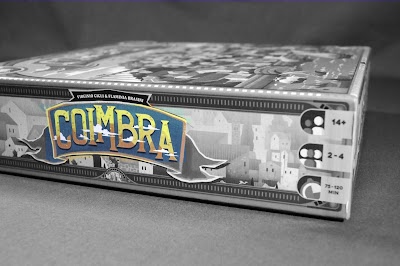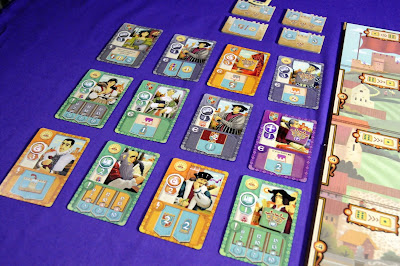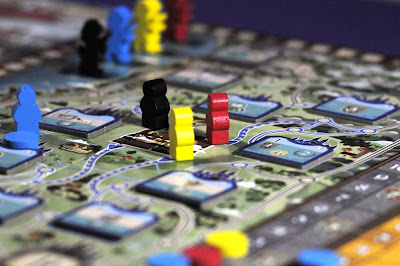COIMBRA
a review of the board game Designed by Flaminia Brasini and Virginio Gigli
Players: 2-4, Time Investment: 60-90 mins
Rating:
 |
| I'm silently crying! |
Game Aesthetic
Components:
Not only is the insert fabulous but the components are absolutely pleasing. I'll go ahead and start with the Rampant Lions: while relatively useless other than for determining turn order, I still find it enjoyable to look at these turn order meeples. Downside is the damn thing always tilts off to the side and it becomes easily part of the game experience to know how to rearrange them without it becoming a dexterity game. You're evaluating turn order every round so it's not like this won't continue to be a part of your life during gameplay.You know what I do appreciate as a permanent part of my life journey through Coimbra? These linen-finish cards! Mind you there isn't a lot of card holding in this game because it's a tableau builder but when you pick them up, it's just... so nice for that brief moment. I'm always a fan of orange and purple in a game, and this game has both in the dice set, tracks, and cards! I've found that if the game doesn't have red and blue, orange and purple tend to be the substitutes. Pop-color fans unite!
Monasteries, which is where your person-shaped meeple wanders about on the board, can be visited by several folks. Instead of having an annoying time lifting the disks off the monasteries to see the benefits they provide, your little discs can be pushed off to the side. They're etched modular cardboard bits, and are always fun to me mainly because it keeps the game fresh and provides a certain level of frustration that is so delectable and yummy. Plus they function and for weirdos like me who like ensuring that everything is in its place, it quells that anxiety as well.
When drafting the die and placing them in the sections of town you want to visit, you need to nestle it into this fortress-looking plastic... thing. It's fun to put together, and provides a fresh take on Place A Thing* mechanics.
But... really? Monasteries? I'm unfamiliar with the geographical significance of these but the cardboard bits don't really look like monasteries to me?
*I don't really regard this as a worker placement but you are placing things but... they're dice so... Place a Thing!
 |
| Dice, Cards, and more Bits! |
Artwork by Chris Quilliams:
I believe the one other complaint -- other than the rampant lion dexterity mini game -- is I'm not even paying attention to city locations or tracks. I mean, I had to look at the book to even know that something was more than just "this color track" but I guarantee you none of the players I have played with now or in the future will refer to them by their thematic names because this game is dry AF to begin with.
Despite its dryness, did I mention this game is SO colorful?! I wanna just stare at it forever, from the geometric, edgy faces reminding me of indie cartoon films to its entertaining and also deceptive depth.I haven't actually bothered to see if there was any connection between the powers or benefit of the cards and whether the art matched thematically in some way. Honestly considering there being distinctly women and men in the game I'm worried that I won't be too happy about discovering the enforced stereotypes.
The peninsula where the monasteries live is also very pretty though I can't really understand how it decides to converge, diverge, lengthen, or stop paths.
I really like the laurels for some reason for points but I don't know enough about the culture to comment on whether the choice was accurate.
Disappointing that the market areas are not more visible, looks like it must have taken some amount of effort to design yet all we are doing in the game is covering it with it with action dice!
The First Turn
Options:
It's very clear that you put a die down to get a thing and what the resources are.The starting cards give you some direction and the hardest thing here is balancing the increases on the tracks from the cards and the activation of those tracks with the die.
You'll need to use different parts of your brain to evaluate the cards, their effects, their symbologies, and their consequences as well as the resources you have available and the track you want to benefit from -- and its consequences. At minimum you can simply pick things that give you resources and figure out what to do with them later. And, of course, you won't be able to get what you want if you don't have resources to spend so that limitation in and of itself is a guide.
Rewards and Objectives:
Voyage Cards are end game scores you can buy into but you can only fund one per round unless you get the special favor tiles.Game End Bonus cards marked with (!) provide some direction, cross-pollinate with other cards, and boost your track standing.
Level III Monasteries and good timing provides instant points, and can even double-up on stuff you've been working on for a while. Another reward for visiting some monasteries early enough is the ability to perpetually provide points when you perform certain actions in the future. Crowns determine turn order and some monasteries care about crowns to translate into points but they aren’t terribly crucial unless you’re in a race with other folks.
Diplomas become a set collection mini game but I'm not familiar with whether the game balances on scarcity or not.
Track Rankings become a race to the top but if you've been maximizing in those areas through your drafts and purchases, then this is more of a side effect rather than a goal. The return on points for being ahead is great so this can arguably influence your decisions for reasons of too much competition (there is one fewer place than there are actual players). The moment you start focusing on your own thing it’ll be too late for everyone else to catch up with you.
The fun and funny thing about this game is the resource limit. I really appreciate when euros provide constraints because a truly talented gamer will know how to work with what little they have rather than hoard something for days. I’ve had some games where I felt very rewarded for acquiring goods.
 |
| Go on a Voyage! |
Ability to Pivot:
There is a possibility to catch up slightly by using green track (i.e. buying green cards, drafting green die) if you need to buy some time to close in the gap because it is straight up points income. Sadly, some attack cards will make it hard to recover but can be mitigated (e.g. I've had games where I was attacked constantly and still won anyway). Not to worry: I was still able to win even with giving up points instead of resources to other players every single time! However if you finally have resources to buy a voyage but you missed out on the round prior, there is a clear lead from the opponents assuming they did find something.Game End
The game ends after four rounds and it feels very fast, but it's one of those games I could easily just play over again after the first session ends. The only issue is because there is a sense of urgency, one can overthink their actions and slow down the rest of the group.But this game is meant to be played quickly, otherwise the cards would arguably be more complicated and intensive as far as options are concerned. I feel as though that is not the intention considering how streamlined the iconography is for this game. Easily can play this for several sessions!





No comments:
Post a Comment
Shed some tears with me!